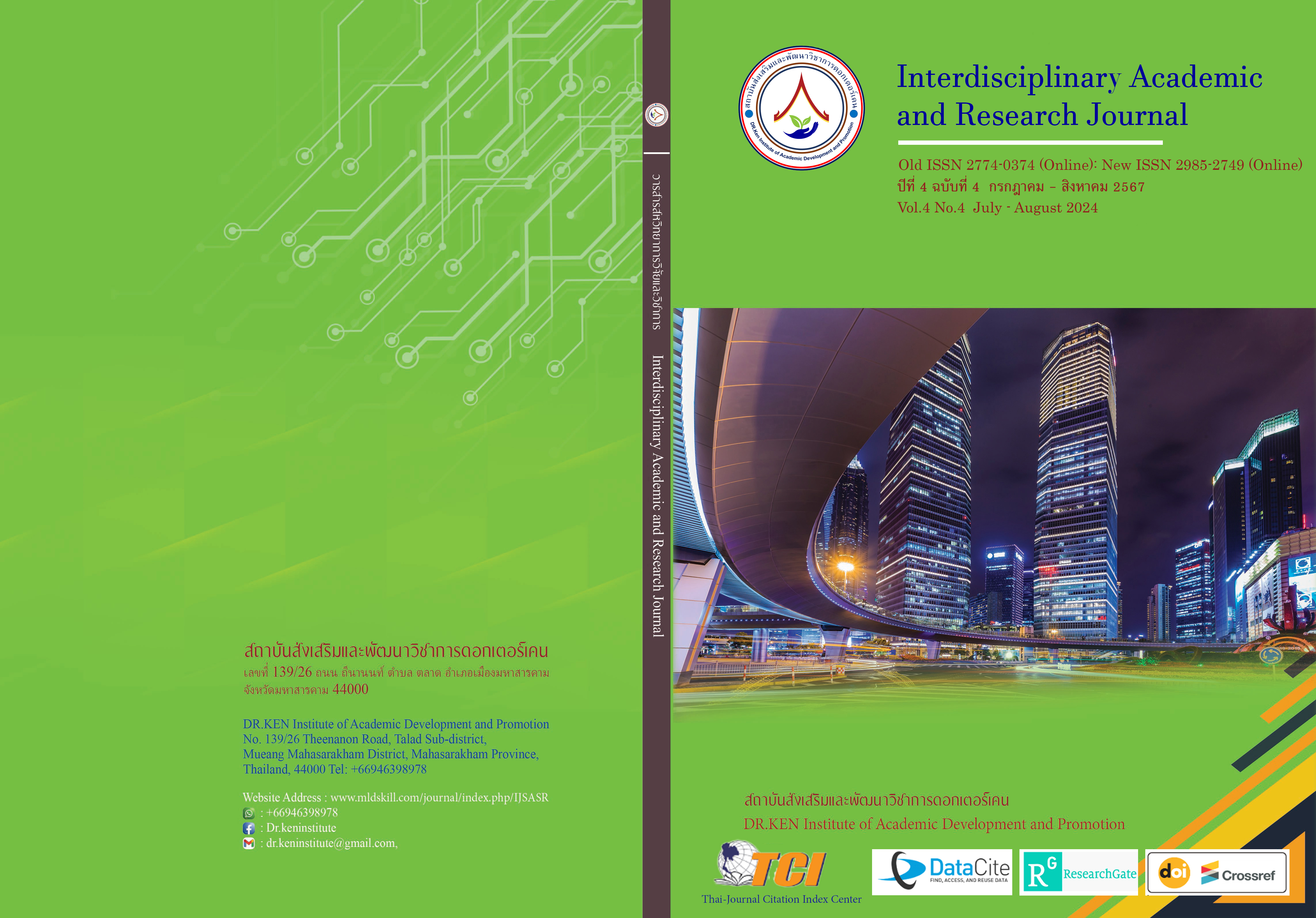A Comparison of Learning Achievement in Labor Law among Third-Year Political Science Students between Peer-Assisted Learning Techniques and Lecture-Based Teaching Method
DOI:
https://doi.org/10.60027/iarj.2024.276597Keywords:
Learning Achievement; , Peer Assist Techniques;, Lecture MethodAbstract
Background and Objectives: Organizing teaching and learning activities in labor law is crucial and necessary for students involved in legal studies. Utilizing peer-assisted learning activities in teaching can help students understand the content and lead to improved learning achievement. This research aims to compare the learning achievement in labor law among third-year Political Science students between peer-assisted techniques and lecture methods and to study the satisfaction levels of the students after implementing peer-assisted learning techniques.
Research Methodology: This research is a quasi-experimental research using a Two-Group Pretest- Posttest design. The study sample consisted of students from the second semester of the academic year 2023 enrolled in the course "Labor Relations Management" (PS2208304), totaling 106 students across 2 classrooms. Classroom 1 was designated as the experimental group while Classroom 2 was designated as the control group. Tools used included group peer-assisted learning lesson plans, lecture-based teaching lesson plans,
achievement assessment tests, and satisfaction surveys. Statistical analyses included mean, standard deviation, and independent t-tests.
Research Findings: 1) Students who underwent peer-assisted learning showed a statistically significant difference in post-learning scores compared to their counterparts taught using lecture-based teaching methods, reaching statistical significance at the .05 level. 2) Third-year Political Science students showed the highest level of satisfaction after participating in peer-assisted learning activities.
Conclusion: This research demonstrates that implementing peer-assisted learning activities through Classwide-peer tutoring with One-to-One Tutoring enhances students' learning development and leads to higher learning achievement. Furthermore, according to the satisfaction survey results, students expressed the highest level of satisfaction across all aspects.
References
กองบริการการศึกษา มหาวิทยาลัยราชภัฏเทพสตรี. (2566). ข้อมูลนักศึกษาประจำปีการศึกษา 2566. Retrieved on 10 May 2023 from: https://reg.tru.ac.th/registrar/home.asp
กันยา มั่นคง. (2563). การศึกษาผลสัมฤทธิ์ทางการเรียนการสอนด้วยเทคนิคการเรียนการสอนแบบเพื่อนช่วยเพื่อน ในรายวิชาการบัญชีเพื่อการจัดการสิ่งแวดล้อมของนักศึกษาโปรแกรมวิชาการบัญชี. วารสารพิกุล, 18(2), 221-233.
ชวลิต ชูกำแพง. (2551). การพัฒนาหลักสูตร. มหาสารคาม: มหาวิทยาลัยมหาสารคาม.
ทิศนา แขมมณี. (2556). ศาสตร์การสอนองค์ความรู้เพื่อการจัดกระบวนการเรียนรู้ที่มีประสิทธิภาพ. กรุงเทพฯ: จุฬาลงกรณ์มหาวิทยาลัย
บุญชม ศรีสะอาด. (2560). การวิจัยเบื้องต้น. พิมพ์ครั้งที่ 10. กรุงเทพฯ: สุวีริยาสาส์น.
เรวัต สุขสิกาญจน์. (2560). เพื่อนช่วยเพื่อน: การศึกษาผลสัมฤทธิ์ทางการเรียนของนักศึกษา รายวิชาทัศนศิลป์เพื่อการออกแบบอุตสาหกรรม เรื่องการวาดเส้น. วารสารศึกษาศาสตร์, 28(1), 195-207.
สุพนิดา อุปทุม, ศุภกร ศรเพชร, เบญจ์ กิติคุณ, วโรทัย สิริเศรณี และ อ้อมทิพย์ มาลีลัย. (2566). การใช้กิจกรรมแบบกลุ่มเพื่อนช่วยเพื่อน เพื่อการพัฒนาผลสัมฤทธิ์ทางการเรียน เรื่อง การสร้างกราฟด้วยโปรแกรม PowerPoint ของนักเรียนชั้นประถมศึกษาปี 5 โรงเรียนบ้านนามูลฮิ้น สังกัดสำนักงานเขตพื้นที่การศึกษาประถมศึกษานครพนม เขต 1. วารสารบัณฑิตศึกษา มหาวิทยาลัยราชภัฏสกลนคร, 20(89), 109-113.
อาภรณ์ ใจเที่ยง. (2553). หลักการสอน (ฉบับปรับปรุง). กรุงเทพฯ: โอเดียนสโตร์.
Bournemouth University. (2002). Peer-Assisted Learning. Retrieved on 10 January 2023 from https://www.Bournemouth. ac.uk/students/library/guests-visitor-information/peerassisted-learning-pal.
Collison, C., & Parcell, G. (2004). Learning to Fly: Practical Knowledge Management from Some of the World’s Leading Learning Organizations. Capstone: Chichester.
Cronbach, L.J. (1970). Essentials of Psychological Test. 5th edition. New York: Harper Collins.
Giordana, S., & Wedin, B. (2010). Peer Mentoring for Multiple Levels of Nursing Students. Nurs Edu Perspect, 31(6), 394-396.
Heron, T.E., & Cooke, N.L. (1982). Tutor Huddle: Key Element in a Class-wide Peer Tutoring System. The Elementary School Journal, 83, 114-123.
Kohn, J.J., & Vajda, P.G. (1975). Peer-mediated Instruction and Small Group Interaction In the ESL Classroom. TESOL Quarterly, 4(9), 379-390.
Kuder, Frederic G., & M.W. Richardson. (1973). The Theory of the Estimation of Test Reliability. Psychometrika, 2, 151-160.
Maheady, L., Mallette, B., Harper, G.F., Sacca, K.C., & Pomerantz, D. (1994). Peer-mediated Instruction for High-Irish Students. In Teaching Reading to High-Irish Learners. MA: Allyn and Bacon.
Shealagh, P., Melanie, F., & Suzanne, B. (2005). Making Connection That Work. Ontario: Environment Canada.
Utay, C.M. (1993). Peer Assisted Learning: The Effect of Cooperative Learning and Cross-age Peer Tutoring on Writing Skills of Students with Learning Disabilities. Doctoral Dissertation, East Texas State University, Dissertation Abstracts International.
Downloads
Published
How to Cite
Issue
Section
License
Copyright (c) 2024 Interdisciplinary Academic and Research Journal

This work is licensed under a Creative Commons Attribution-NonCommercial-NoDerivatives 4.0 International License.
Copyright on any article in the Interdisciplinary Academic and Research Journal is retained by the author(s) under the under the Creative Commons Attribution-NonCommercial-NoDerivatives 4.0 International License. Permission to use text, content, images, etc. of publication. Any user to read, download, copy, distribute, print, search, or link to the full texts of articles, crawl them for indexing, pass them as data to software, or use them for any other lawful purpose. But do not use it for commercial use or with the intent to benefit any business.
















.png)


